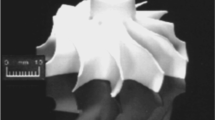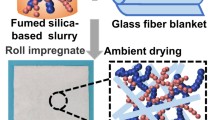Abstract
The production of foamed silicate materials using foam glass technology promotes using of environmentally friendly fire-resistant heat-insulating materials. At the same time, it is urgent to search for different silicate materials, which could be used instead of common glass powder. A new promising way to produce foamed silicate materials is “hydrate” foaming. It is based on an interaction between SiO2 and alkali solution with a formation of sodium hydrosilicate mixture. Further heating leads to a water vapor release that forms the softened silicate mass. This study describes the technology of preparation and heat treatment of initial raw mixtures, their synthesis, the properties of the synthesized samples (density, porosity) and their internal structure. A comparative analysis of the processes occurring during the heat treatment of the initial diatomite and the developed compositions was performed. The processes occurring during foaming of foam glass using a “waterglass–glycerol” mixture were considered using differential thermal calorimetry. The role of each component of the mixture was revealed, and the perspective of their introduction was justified, as it allows obtaining a material with a density of 190 kg m−3.






Similar content being viewed by others
References
Brusatin G, Bernardo E, Scarinci G. Production of foam glass from glass waste. In: Proceedings of the international conference on sustainable waste management and recycling: glass waste. 2004. p. 67–9.
Éidukyavichus KK, Matselkene VR, Balkyavichus VV, et al. Use of cullet of different chemical compositions in foam glass production. Glass Ceram. 2004;61(3–4):77–80.
Liu Y, Chen W, Liu M. The effect of foaming temperature on the foam glass by using waste glass. Gongneng Cailiao. J Funct Mater. 2016;47:135–41.
Yatsenko EA, Goltsman BM, Smolii VA, Yatsenko LA. Perspective and experience of use of glass fraction of solid municipal waste in the production of silicate heat-insulating materials. In: Proceedings of the 2018 IEEE international conference “management of municipal waste as an important factor of sustainable urban development”, WASTE 2018. 2018. p. 46–8.
Bulgakov A, Erofeev V, Bogatov A, Smirnov V. Innovative production technology of binding and building composite materials on the basis of glass wastes. In: Zingoni A, editor. Insights and innovations in structural engineering, mechanics and computation. London: Taylor & Francis Group; 2016. p. 1583–6.
Bernardo E, Scarinci G, Hreglich S. Foam glass as a way of recycling glasses from cathode ray tubes. Glass Sci Technol. 2005;78(1):7–11.
Mear F, Yot P, Cambon M, Caplain R, Ribes M. Characterisation of porous glasses prepared from Cathode Ray Tube (CRT). Powder Technol. 2006;162(1):59–63.
Méar F, Yot P, Cambon M, Ribes M. Elaboration and characterisation of foam glass from cathode ray tubes. Adv Appl Ceram. 2005;104(3):123–30.
Chen B, Wang K, Chen X, Lu A. Study of foam glass with high content of fly ash using calcium carbonate as foaming agent. Mater Lett. 2012;79:263–5.
Chen B, Luo Z, Lu A. Preparation of sintered foam glass with high fly ash content. Mater Lett. 2011;65(23–24):3555–8.
Zhao Y, Ye J, Lu X, et al. Preparation of sintered foam materials by alkali-activated coal fly ash. J Hazard Mater. 2010;174:108–12.
Gots VI, Germash KM. Influence of modifying admixtures on properties of foam glass obtained by using ashes resulting from incineration of household waste. In: Proceedings of the international conference on achieving sustainability in construction. 2005. p. 67–73.
Chuang K-H, Lu C-H, Chen J-C, Wey M-Y. Reuse of bottom ash and fly ash from mechanical-bed and fluidized-bed municipal incinerators in manufacturing lightweight aggregates. Ceram Int. 2018;44(11):12691–6.
Xu B, Liang KM, Cao JW, Li YH. Preparation of foam glass ceramics from phosphorus slag. Adv Mater Res. 2010;105–106(1):600–3.
Ding L, Ning W, Wang Q, et al. Preparation and characterization of glass–ceramic foams from blast furnace slag and waste glass. Mater Lett. 2015;141:327–9.
Ponsot I, Bernardo E. Self glazed glass ceramic foams from metallurgical slag and recycled glass. J Cleaner Prod. 2013;59:245–50.
Liu T, Lin C, Liu J, et al. Phase evolution, pore morphology and microstructure of glass ceramic foams derived from tailings wastes. Ceram Int. 2018;44(12):14393–400.
Liu TY, Tang Y, Li Z, Luo WT, Lu AX. Red mud and fly ash incorporation for lightweight foamed ceramics using lead-zinc mine tailings as foaming agent. Mater Lett. 2016;183:362–4.
Xi C, Zheng F, Xu J. Preparation of glass-ceramic foams using extracted titanium tailing and glass waste as raw materials. Constr Build Mater. 2018;190:896–909.
Yin H, Ma M, Bai J, et al. Fabrication of foam glass from iron tailings. Mater Lett. 2016;185:511–3.
Liao YC, Huang CY. Glass foam from the mixture of reservoir sediment and Na2CO3. Ceram Int. 2013;38(5):4415–20.
Sharma D, Farah K. Dynamics of induced glass transition of porous and nonporous silica nanoparticles. J Therm Anal Calorim. 2018;132:181–9.
Davraz M, Koru M, Bayrakçi HC, et al. The effect of opacifier properties on thermal conductivity of vacuum insulation panel with fumed silica. J Therm Anal Calorim. 2020. https://doi.org/10.1007/s10973-020-09277-8.
Kazantseva LK, Yusupov TS, Lygina TZ, et al. Foam glass from mechanoactivated zeolite-poor rock. Glass Ceram. 2014;70(9–10):360–4.
Kazantseva LK, Rashchenko SV. Optimization of porous heat-insulating ceramics manufacturing from zeolitic rocks. Ceram Int. 2016;42(16):19250–6.
Volland S, Vereshchagin V. Cellular glass ceramic materials on the basis of zeolitic rock. Constr Build Mater. 2012;36:940–6.
Saakyan ER. Multifunctional foam glasses from volcanic glassy rocks. Glass Ceram. 1991;48(1–2):3–5.
Shimono Y, Nishida M, Seki Y. Production of foam glass made from glassy volcanic ashes as main material resources. Yogyo Kyokai Shi J Ceram Soc Jpn. 1987;95(5):494–502.
Seki Y. Production of the Shirasu rich foam glass in the system Shirasu-glass–water glass. Yogyo Kyokai Shi J Ceram Soc Jpn. 2005;91(8):367–74.
Kaz’mina OV, Vereshchagin VI, Semukhin BS. Structure and strength of foam-glass-crystalline materials produced from a glass granulate. Glass Phys Chem. 2011;37(4):371–7.
Kutolin VA, Shuloyakov AD, Shirokikh VA. Physical and chemical methods of production of aggregate from fine solid minerals for lightweight concrete. Obogashchenie Rud. 2013;5:46–8.
Yatsenko EA, Goltsman BM, Ryabova AV, Smoliy VA. Peculiarities of the use of siliceous raw materials of the Russian Far East in the integrated pipeline protection. In: MATEC web of conferences. 2018;242. p. 01016.
Lotov VA. Making foam glass based on natural and technogenic aluminosilicates. Glass Ceram. 2012;68(9–10):302–5.
Manevich VE, Subbotin RK, Nikiforov EA, et al. Diatomite–siliceous material for the glass industry. Glass Ceram. 2012;69(5–6):168–72.
Reka AA, Pavlovski B, Makreski P. New optimized method for low-temperature hydrothermal production of porous ceramics using diatomaceous earth. Ceram Int. 2017;43(15):12572–8.
Jiang F, Zhang L, Jiang Z, et al. Diatomite-based porous ceramics with high apparent porosity: pore structure modification using calcium carbonate. Ceram Int. 2019;45(5):6085–92.
Yatsenko EA, Smolii VA, Goltsman BM, et al. Optimal fractional composition of batch for synthesis of foam-glass materials based on diatomite from the chernoyarskoe deposit. Glass Ceram. 2019;75(9–10):391–3.
Melkonyan RG. Kanazite: a Promising Material for Glass Melting. Glass Ceram. 2002;59(9–10):314–8.
Il’ina VP, Shelekhova TS. Diatomites of Karelia for glass production. Glass Ceram. 2009;66(3–4):109–12.
Efremenkov VV, Manevich VE, Subbotin RK. Development of a technology for producing quenched cullet for foam glass manufacture. Glass Ceram. 2013;69(9–10):291–4.
Ivanov KS, Radaev SS, Selezneva OI. Diatomites in granular foam-glass technology. Glass Ceram. 2014;71(5–6):157–61.
Yatsenko EA, Goltsman BM, Ryabova AV. Complex protection of pipelines using silicate materials based on local raw materials of the far East. Mater Sci Forum. 2019;945:46–52.
Particle Size Conversion Table. Date http://www.sigmaaldrich.com/chemistry/stockroom-reagents/learning-center/technical-library/particle-size-conversion.html. Accessed 10 June 2019.
da Silva RC, Kubaski ET, Tenório-Neto ET, et al. Foam glass using sodium hydroxide as foaming agent: study on the reaction mechanism in soda-lime glass matrix. J Non-Cryst Solids. 2019;511:177–82.
Roggendorf H, Böschel D, Trempler J. Structural evolution of sodium silicate solutions dried to amorphous solids. J Non-Cryst Solids. 2001;293–295:752–7.
Shill F. Penosteklo (Foam glass). Moscow: Building Publisher; 1965 (in Russian).
Demidovich BK. Proizvodstvo i Primenenie Penostekla (Production and application of foam glass). Minsk: Nauka i Tekhnika; 1972 (in Russian).
Petersen RR, König J, Yue Y. The viscosity window of the silicate glass foam production. J Non-Cryst Solids. 2017;456:49–54.
Appen AA. Khimiya Stekla (Chemistry of glass). Leningrad: Khimiya; 1970 (in Russian).
Sun J, Chen Z. Effect of silicate modulus of water glass on the hydration of alkali-activated converter steel slag. J Therm Anal Calorim. 2019;138:47–56.
Compound summary: Glycerol. In: PubChem. https://pubchem.ncbi.nlm.nih.gov/compound/Glycerol Accessed 21 July 2019.
Shelby JE. Introduction to glass science and technology. 2nd ed. New-York: Royal Society of Chemistry; 2005.
Acknowledgements
The work was supported by the Russian Science Foundation, Project # 18-19-00455 “Development of complex protection technology for oil and gas pipelines, operated in the Far East of Russia” in the framework of the 2018 competition “Conducting fundamental scientific research and exploratory scientific research by individual scientific groups.”
Author information
Authors and Affiliations
Corresponding author
Additional information
Publisher's Note
Springer Nature remains neutral with regard to jurisdictional claims in published maps and institutional affiliations.
Rights and permissions
About this article
Cite this article
Yatsenko, E.A., Goltsman, B.M., Klimova, L.V. et al. Peculiarities of foam glass synthesis from natural silica-containing raw materials. J Therm Anal Calorim 142, 119–127 (2020). https://doi.org/10.1007/s10973-020-10015-3
Received:
Accepted:
Published:
Issue Date:
DOI: https://doi.org/10.1007/s10973-020-10015-3




